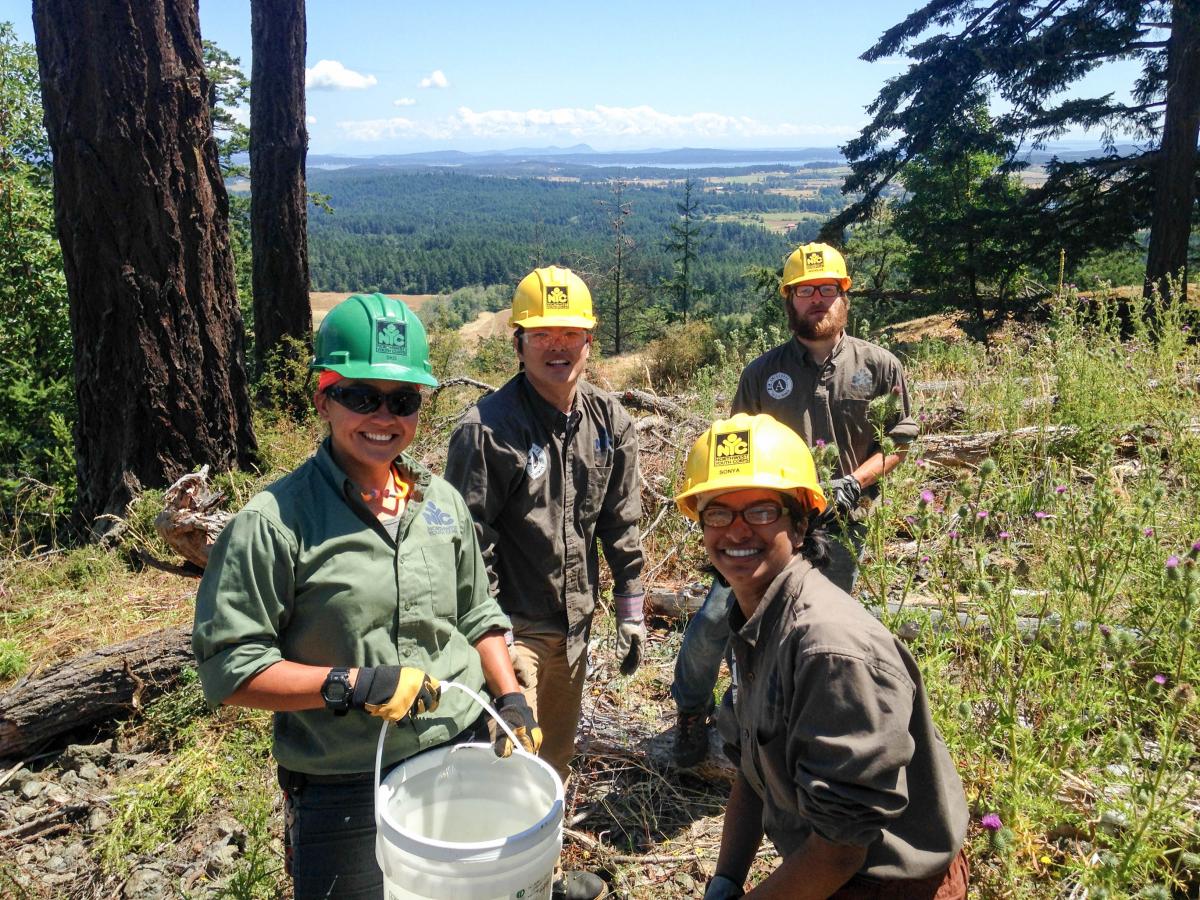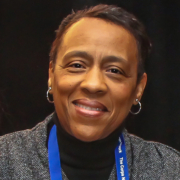

Inclusivity in the Corps World
Everyone faces small daily challenges and uncertainties. Fortunately, for many of us in this country, our troubles are relatively trivial. For those in the Deaf and Hard-of-Hearing community, however, communication barriers can make it prohibitively difficult to participate in basic interactions. In recognition of Deaf History Month, we’re looking at steps taken by America’s service and conservation Corps to make the workplace and the outdoors more accessible for the Deaf and Hard-of-Hearing.
Unfortunately, Deaf and Hard-of-Hearing individuals have fewer employment options due to a lack of resources in the workplace and preconceived notions about their abilities. It can be particularly difficult for a Deaf or Hard-of-Hearing young person with limited job experience to gain a foothold in the workforce. Recognizing this issue, the Corps community has gradually increased the presence of inclusive crews since the mid-1970’s and early 1980’s.
Based on the model of the Civilian Conservation Corps of the 1930s, modern Corps are locally-based organizations that engage youth and recent veterans in service projects that address conservation and community needs. Through their service, Corps participants – or “Corpsmembers” – gain work experience and develop in-demand skills. Corpsmembers are compensated with a modest stipend and have access to mentors and counselors.
There are over 130 Corps across the country. While not all Corps have the resources to offer disability inclusion programs, several have made concerted efforts to expand their inclusivity. There are currently five Corps across the nation that provide employment, service, and volunteering opportunities for Deaf and Hard-of-Hearing youth and young adults. Corps with such programs include, Northwest Youth Corps (OR/WA), Conservation Corps Minnesota & Iowa (MN), Rocky Mountain Youth Corps (NM), Vermont Youth Conservation Corps (VT), and Utah Conservation Corps (UT). We reached out to these organizations, as well as CorpsTHAT, a non-profit specializing in helping Corps develop ASL-inclusion programs.
How it Works
Corps typically operate under a “crew model” in which Corpsmembers serve together in small teams under the supervision of trained adults. ASL inclusive crews typically consist of hearing participants, Deaf and Hard-of-Hearing participants, and ASL interpreters. Members of these crews work together on building and improving trails, restoring habitats, removing invasive species, and numerous other conservation projects. Projects usually take place on public lands and waters, including properties managed by agencies like the National Park Service and U.S. Forest Service.
Through inclusive crews, Corps help people in the Deaf community explore the outdoors in a safe, welcoming manner. In addition to learning about cultural differences, participants in inclusive crews gain valuable leadership and communication skills as they create bonds with those who may be different from themselves.
“It gives members a chance to gain empowering real-life skills through a meaningful employment experience,” said Sean Damitz, Director of Utah Conservation Corps.
The primary goal for Corps that provide these programs is to diversify populations they serve and promote cultural exchange among youth in their programs. Although some youth are pushed out of their comfort zones, learning new ways to communicate and work with others is extremely valuable.
Progression of Inclusion Practices
In the Midwest
Conservation Corps Minnesota & Iowa has served youth in the Deaf and Hard-of-Hearing community since the mid-1970s. What started as a business relationship between the Corps and local summer camps for the Deaf, flourished into the inclusion of Deaf individuals in CCMI programs over the last thirty years.
Under CCMI’s crew model, the majority of Corpsmembers and crew leaders are Deaf, but there are a few hearing youth, as well as a crew leader who interprets. Other Corps, such as Northwest Youth Corps, have crews comprised entirely of Deaf or Hard-of-Hearing youth, with the occasional participant who is the child of Deaf adults. Still other programs incorporate a few Deaf and Hard-of-Hearing youth into a crew comprised predominately of hearing youth. All of these models provide participants of different abilities the opportunity to teach one another about their different cultures while working towards the common goal of completing the conservation project at hand.
Keeping Deaf individuals in leadership positons has proven to be a challenge for CCMI. Jonathan Goldenberg, CCMI’s Summer Youth Corps Program Manager explains, “As we do not have a full-time office staff member who is fluent in ASL, it becomes harder to share our program with the Deaf community.”
Working with new project sponsors has also been somewhat of a challenge. Project sponsors are usually local, state and federal resource management agencies that engage the Corps in conservation service. In the beginning, sponsors are a little unsure how to interact with the inclusive crews. After that initial awkwardness, however, a comfort level develops between both groups. The essential goal for CCMI’s inclusion program is to transcend fear of communication with those of various backgrounds.
“Many hearing youth have never had the opportunity to interact with Deaf youth, and the Deaf youth have the opportunity to share their language and culture with hearing youth who are super excited to learn (and in that, the Deaf youth learn from the hearing youth as well),” said Goldberg.
In the Pacific Northwest
In 2013, with the help of CorpsTHAT founders Emma Bixler and Sachiko Flores, Northwest Youth Corps (NYC) began their first disability inclusion crew. Although the first season was small, over the years it has grown into a renowned program, winning The Corps Network’s 2017 Project of the Year Award.
NYC’s success comes from offering two programs: one consisting of youth ages 16-19, the second with adults ages 19-24. Participants in each session work for five to eight weeks, which allows two sessions each summer. Crews travel throughout Washington, doing various types of restoration work in state and national parks and forests. The initial goal of starting a program like this was to provide Deaf and Hard-of-Hearing individuals support, a comfortable space, and an equitable environment to experience the outdoors in our hearing-dominant world.
Even though NYC has experienced many successes with this program, they continue to face lack of support. Inclusion Coordinator, Darian Lightfoot states, “The largest challenge I’ve seen is people being unaware of Deaf culture and how to support equitable communication. All the information that hearing people are exposed to should be accessible to people using ASL, and that doesn’t always happen.”
Despite the communication barrier, hearing youth request to be on the ASL inclusion crew. This is a prime example of how valuable inclusive crews are to everyone involved. Lightfoot explains, “These hearing youth are able to see that the participants in the ASL inclusion crew are their peers and enjoy all the same things as them.”
In New England
Vermont Youth Conservation Corps (VYCC) continues the progression of inclusive crews, recently winning a Public Lands Alliance Award for their partnership with the US Forest Service (USFS) to engage the Deaf community. Last year, VYCC expanded their partnership with USFS through a collaboration with the Lexington School for the Deaf in Queens, NY. Through these partnerships, VYCC provided a cutting-edge inclusive conservation program. Youth completed various conservation projects at Green Mountain and Finger Lakes National Forests in Vermont and New York.
During the four-week program, hearing members quickly adapted to using sign language, and Hard-of-Hearing youth were provided the support to successfully complete the projects at hand. Executive Director Breck Knauft states, “Having Deaf and hearing Corpsmembers work side-by-side exemplifies our belief that bringing people from different backgrounds together in service creates conditions for powerful learning.” VYCC also serves youth with different types of disabilities, including those with learning disabilities, vision impairment and blindness.
“The most rewarding aspect is watching people grow through their experience and overcome challenges they found daunting at the start of their service. Seeing the changes someone may go through in just 4 weeks is amazing. Also, talking with people whose lives were impacted be the program in the past, I often hear stories of people who were on a crew long ago and it changed their outlook on life”, Patrick Pfeifer, Conservation Program Director.
Barriers to Inclusion
“Deaf and Hard-of-Hearing Corps programs are very important because Deaf and Hard-of-Hearing people are often excluded from serving country and community due to the barriers and lack of opportunities,” said Emma Bixler and Sachiko Flores, founders of CorpsTHAT. “Corps programs help open great opportunities for Deaf and Hard-of-Hearing people to volunteer, show their community involvement on their résumés, and use their experience to obtain jobs.”
However, developing a successful inclusion program is not easy. Created in 2007, the Utah Conservation Corps (UCC) inclusive crew has seen its fair share of setbacks in terms of procuring funding and sponsors to run their program on an annual basis. Even so, their main challenge continues to be the accessibility of recreational sites. Their program engages individuals with various types of physical disabilities, not just those from the Deaf and Hard-of-Hearing community.
UCC developed a disability inclusion toolkit to inspire Corps around the country to develop their own inclusive programs. UCC credits accessibility condition surveys as the critical first step in determining if spaces are safe and welcoming for disabled participants on their crew. These surveys include a variety of tests and measurements: Are trails passable by a wheelchair? Do videos in the interpretation center have closed captions? In 2009, UCC assisted the U.S. Forest Service in developing a national database of information on the accessibility of public lands.
As opposed to more obvious structural issues that may limit the work of other inclusive crews, CorpsTHAT considers people’s assumptions and misunderstandings as the major barriers faced by Deaf and Hard-of-Hearing crews specifically. For the most part, the average hearing person has limited or no experience working with Deaf individuals. Both parties face fears of miscommunication, inaccurate assumptions, and lack of confidence in their ability to perform.
“When Deaf participants have full access to communication and are on the crews with other Deaf participants, the uncertainty is removed and all participants are able to have a barrier-free experience,” Said Bixler and Flores.
CorpsTHAT believes inclusion crews have unique benefits hearing crews lack. For example, inclusion crews’ productivity and attention level is at a higher rate than hearing crews. Due to their inability to comfortably communicate and work at the same time or hold side conversations, interruptions are scarce; all their focus and energy is geared towards completing the task at hand. Another benefit of inclusion crews is the strength of Deaf crew members’ visual-spatial abilities, which aid in solving problems or completing projects faster.
Though inclusive crews offer numerous benefits, one of the most rewarding aspects is providing all individuals – regardless of their abilities – the opportunity to serve our country through conservation efforts. Feeling safe and comfortable working outdoors is something many of us take for granted; these programs make conservation work something that more people can experience. Inclusive crews at Corps demonstrate that any workplace can adjust be more inclusive. The young people on these crews start off as strangers, but they face communication barriers head on and take the time to understand one another, despite cultural differences.


































































